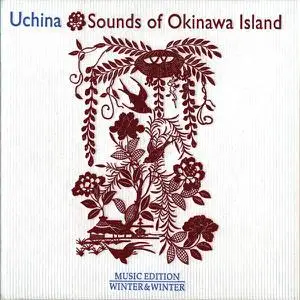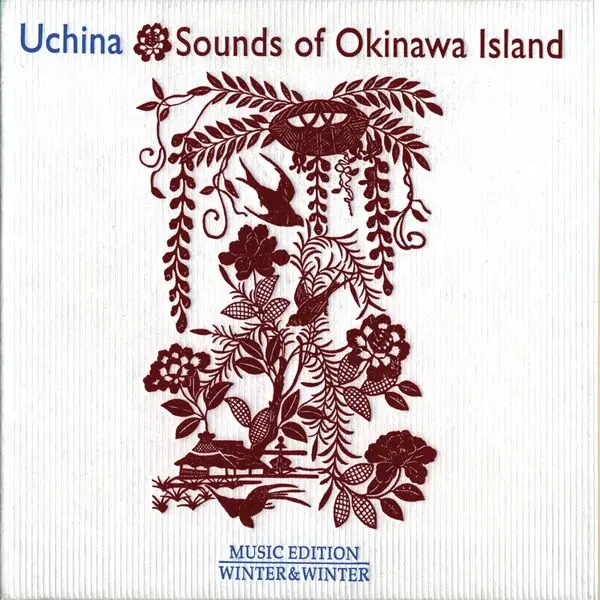VA - Uchina - Sounds of Okinawa Island (2013)
EAC Rip | FLAC (tracks, cue, log) - 444 MB | MP3 CBR 320 kbps - 203 MB
1:26:44 | Classical, Folk, World | Label: Winter & Winter
EAC Rip | FLAC (tracks, cue, log) - 444 MB | MP3 CBR 320 kbps - 203 MB
1:26:44 | Classical, Folk, World | Label: Winter & Winter
Islands develop a sound of their own. Not only the unique rhythms, songs and compositions are unmistakable but also the sound of the woods, of the waves, of the wind and the noises in market halls and in the villages are as unusual as the mentality of the islanders. Islands are self-contained 'small worlds' with their own rules and own character. Okinawa is such a distinguishable island in Japan. The audible travel journal »Uchina« (»Okinawa«) will put you in touch with an enchanted power of a sound, full of magic and traditional culture, maybe unfamiliar for Western people, but worth a voyage of discovery into a wondrous sound world with high sensitivity.
Years ago Mariko Takahashi and Stefan Winter start a series of musical travelogues and some of the most exciting and beautiful records were composed with authentic sounds which only can be found where the tradition still exists in this age of globalisation. Here, we must distinguish between two phenomenons of keeping the traditional sounds. On the one side you can find organizations who are interested in keeping the heritage of ancestors with grim determination. Very often these groups do not allow any development and the tradition stands still. On the other side the tradition is alive if the tradition is in motion. One generation passes on in a natural way to the next generation their musical heritage. In our times this latter development seems to be oppressed by the international standardization. It is particularly fascinating to watch if the cultural characteristics will be washed out or revive.
The album »Uchina« penetrates the enchanting world of sounds of this special island to open a treasure chest. On Okinawa the tradition is alive, the art of singing, playing taiko and sanshin lives on in often new and unusual ways, but still follows tradition. The listener can experience classical music that has been performed at the court of the Ryukyu Kingdom, which ruled most of the Ryukyu Islands from the 15th century to the 19th century. The Kings of Ryukyu unified Okinawa Island. Only towards the end of the 19th century Okinawa became a part of Japan. Okinawan culture is quite different from that of other prefectures in Japan. For example, Okinawa is known for its Ryukyu music, Eisa-dance, and many other traditions like Shimadaiko. Taiko (drums), the sanshin (a three-string-instrument similar to a banjo) and vocals are the main sound elements of Okinawa’s music. Since over fifty years it was for the first time possible to record Awase-Chondara which is a very special performance art. It was also very important for this project to capture the sounds of the wind and waves beating the rocks. Hundreds of young girls jumped over a cliff in the south of Okinawa and killed themselves at the end of the battle of Okinawa in 1945. The Sound of Okinawa speaks to the world outside the island and has something to tell, if only we are ready to listen.
A drum piece called »Nami« is the opening track. The taiko performed by Keiko Higa & Shimadaiko (a group of women) transfers human emotion into the wave's rhythm and the energy of the ocean.
The singer and sanshin player Bokusho Kinjo – one of the most influential Okinawan artists born in 1901 – plays the traditional song »Hwishi-Bushi«. When the tide rises, the birds feel bitter because they are loosing ground. And the man feels really bitter when the early bird starts singing because his love must leave.
Keiko Higa & Shimadaiko present the song »Mizu-aya«. When you throw a stone into the water, the waves begin to spread circularly in all directions. This music is a wonderful example that the tradition continues in this new compositions with new expression.
The very young artist Hajime Nakasone who can be heard almost every night in a music club in Naha, the capital of Okinawa sings and plays »Yutakara-bushi«. The strings of his sanshin transform the longing cry for the faraway lover into a melancholic song. Nakasone continues the tradition of the art of sanshin, he listens carefully to the old masters, learns the musical craftsmanship and develops his own new style. With »Amakaa« he presents with his fascinating virtuosity a song about love and desire. Please love me deeper than the depth of the Amakaa lake in Kadena.
»Miyako Nishibe Yukui: Michiyuki Yonteru«, the sixth piece in the middle of this album has a very special history. The women from the little island Miyako perform a prayer for a good harvest and richness, this shamanistic ceremony reflects here the centuries-old tradition. In the middle of the track when the voices call 'Yonteru' (vintage recording from 1981) a chanting in chorus of the people from Okinawa (recorded in 2011 as a protest against the new US military heliport) arises and resounds over the islands and onto the sea. After World War II Okinawa was 'part' of the USA. Consideration was given to the possibility to connect Okinawa as a Federal State of the US like Hawai'i. It was not before 1972 that the US government returned the islands to the Japanese administration. Okinawa was a key staging point of the US army during the Korean War. Until today the US military bases are omnipresent and active. This music is dedicated to the people in Okinawa protesting against the military bases being responsible for environmental degradation.
Toru Yonaha is one of the most famous Okinawan artists who brings court music to the listening ear. Okinawa was part of the kingdom Ryukyu (the 2nd Sho-Dynastie existed until 1879). »Hiden-nakafu« was performed in the court of the king in the middle of the 19th century. Today Toru Yonaha has many students who want to learn and perform the tradition of Ryukyu's court music. Parallels might well be drawn with the situation that arose with European Baroque music.
The special performance art »Chondara« (originally from Kyoto) is known in Okinawa since the 17th/18th century. The festival performance takes place in front of people's houses. The performers wear costumes and some of them traditional hats. The group plays and sings, and performs in one part a 'horse dance', and uses in another part fans to ward off evil spirits. This national intangible folk cultural asset continues to this day in Awase of Okinawa City.
The four sisters Deigo Musume perform »Kunjansabakui« a worker's song about the construction of the Shuri Castle, which stands in the middle of Naha and is as fascinating as the castles at the Loire. The Shuri Castle was ruled by Chuzan (1322 –1429) and the Ryukyu Kingdom (1429–1879).
The two compositions »Naaku-nii / Hantabaruu« are old folk songs which are also presented by Deigo Musume, one of the most popular groups in Okinawa.
The noises of the market hall in Makishi Kosetsu leads to the music of Eisa. This final act of the album »Uchina« is performed by the group Nakanomachi Seinenkai. Very young players – most of them under 20 years – meet during the whole year to practice Eisa. In summer time the performers play at huge and important ceremonies to mark the end of the Obon Festival, which is annually celebrated to honor the spirit of the ancestors.
In the music of Okinawa resounds the history and the future. It might seem to be an anachronism that the strong will-power of the Okinawan people made it almost impossible for the US Army to defeat this little island. Although the length only measures 100 km, the island became a ghastly scene of mass carnage. This battle might have been the reason that the US Army lost the confidence to be able to win in a conventional war against Okinawa's big brother Japan in 1945. For the very first time nuclear bombs were dropped.
Tracklist
[5:54] 1. Keiko Higa - Nami
[3:17] 2. Traditional - Hwishi-Bushi
[11:15] 3. Keiko Higa - Mizu-Aya
[4:23] 4. Choki Fukuhara - Yutakara-Bushi
[3:38] 5. Traditional - Amakaa
[7:14] 6. Traditional - Miyako Nishibe Yukui
[6:04] 7. Traditional - Hiden-Nakafu
[16:28] 8. Traditional - Chondara
[4:22] 9. Traditional - Kunjansabakui
[6:16] 10. Traditional - Naaku-Nii/Hantabaruu
[2:14] 11. Traditional - At Makishi Kosetsu Market
[15:51] 12. Traditional - Eisa: Tooshin Doi
–––––––––––-
DON'T MODIFY THIS FILE
–––––––––––-
PERFORMER: auCDtect Task Manager, ver. 1.6.0 RC1 build 1.6.0.1
Copyright © 2008-2010 y-soft. All rights reserved
http://y-soft.org
ANALYZER: auCDtect: CD records authenticity detector, version 0.8.2
Copyright © 2004 Oleg Berngardt. All rights reserved.
Copyright © 2004 Alexander Djourik. All rights reserved.
FILE: 12 - Eisa_ Tooshin Doi.flac
Size: 97306299 Hash: 05F5FEC98CA68EEF79134FA74CE12AFB Accuracy: -m8
Conclusion: CDDA 100%
Signature: EBCF10FAFEBA6AAE8FAB371CEEE8A9DB43AA3B34
FILE: 11 - At Makishi Kosetsu Market.flac
Size: 11496077 Hash: 380099C9D40EDC2D491119A17E329347 Accuracy: -m8
Conclusion: CDDA 100%
Signature: F26D5A416CBE7E09F35B072D285C97A86AF25E62
FILE: 10 - Naaku-Nii_Hantabaruu.flac
Size: 33775852 Hash: E5D97F545BBF5FB0007E83DBF32CE7D4 Accuracy: -m8
Conclusion: CDDA 100%
Signature: 044A3E3A76FCAFCC2222901FA71A9F84894FC908
FILE: 09 - Kunjansabakui.flac
Size: 25194420 Hash: 17EB1F8FA1D99CBB1C8B08D8ABAA4DF0 Accuracy: -m8
Conclusion: CDDA 100%
Signature: C989E25F5FA0AB11B0DF64ECB95E11A111B0A245
FILE: 08 - Chondara.flac
Size: 84575151 Hash: B4452DB92CD67E304CF99F1D07A0DFBE Accuracy: -m8
Conclusion: CDDA 100%
Signature: 5E702540DF979DF5DF06B1B6025DB543101ACA14
FILE: 07 - Hiden-Nakafu.flac
Size: 31508588 Hash: 9B7044E726D88804B9F9AE986D50EDE0 Accuracy: -m8
Conclusion: CDDA 99%
Signature: 269A74C72B76154A477D7D56EE4AC508D15D83F4
FILE: 06 - Miyako Nishibe Yukui.flac
Size: 38517014 Hash: 24FE407A4CDAD5B16115D190DB549E3E Accuracy: -m8
Conclusion: CDDA 100%
Signature: F132AD3ACE5F89B9DAEB01D8B33FFDEF39754563
FILE: 05 - Amakaa.flac
Size: 21321220 Hash: E6DE061363383AF423D8EFDA1A4301D8 Accuracy: -m8
Conclusion: CDDA 100%
Signature: 2E24F14946128DA79DF5E94B524118905D332544
FILE: 04 - Yutakara-Bushi.flac
Size: 22433088 Hash: 1B86CEAA80A3157359B0EF7AD35F692D Accuracy: -m8
Conclusion: CDDA 100%
Signature: B6D48E1CF1154A7796883CA8E3ECF2D192E7BB74
FILE: 03 - Mizu-Aya.flac
Size: 54426786 Hash: 2E9961B3CF1D93BD470F168E4B921001 Accuracy: -m8
Conclusion: CDDA 100%
Signature: CA2E827C97E2AE889D23FC91C63F5A530578BE61
FILE: 02 - Hwishi-Bushi.flac
Size: 17503611 Hash: E6FD2A7A04CF3D6413D320001DACEF6F Accuracy: -m8
Conclusion: CDDA 100%
Signature: 23A2D1A5C2728C66899CB01013EE9301F2428BA7
FILE: 01 - Nami.flac
Size: 27513472 Hash: 58357B03C6E6CBB7BF4073F16CE0054B Accuracy: -m8
Conclusion: CDDA 100%
Signature: 1031CCDDA51EE3B7C7B4A4F3B01767BCA448541B
DON'T MODIFY THIS FILE
–––––––––––-
PERFORMER: auCDtect Task Manager, ver. 1.6.0 RC1 build 1.6.0.1
Copyright © 2008-2010 y-soft. All rights reserved
http://y-soft.org
ANALYZER: auCDtect: CD records authenticity detector, version 0.8.2
Copyright © 2004 Oleg Berngardt. All rights reserved.
Copyright © 2004 Alexander Djourik. All rights reserved.
FILE: 12 - Eisa_ Tooshin Doi.flac
Size: 97306299 Hash: 05F5FEC98CA68EEF79134FA74CE12AFB Accuracy: -m8
Conclusion: CDDA 100%
Signature: EBCF10FAFEBA6AAE8FAB371CEEE8A9DB43AA3B34
FILE: 11 - At Makishi Kosetsu Market.flac
Size: 11496077 Hash: 380099C9D40EDC2D491119A17E329347 Accuracy: -m8
Conclusion: CDDA 100%
Signature: F26D5A416CBE7E09F35B072D285C97A86AF25E62
FILE: 10 - Naaku-Nii_Hantabaruu.flac
Size: 33775852 Hash: E5D97F545BBF5FB0007E83DBF32CE7D4 Accuracy: -m8
Conclusion: CDDA 100%
Signature: 044A3E3A76FCAFCC2222901FA71A9F84894FC908
FILE: 09 - Kunjansabakui.flac
Size: 25194420 Hash: 17EB1F8FA1D99CBB1C8B08D8ABAA4DF0 Accuracy: -m8
Conclusion: CDDA 100%
Signature: C989E25F5FA0AB11B0DF64ECB95E11A111B0A245
FILE: 08 - Chondara.flac
Size: 84575151 Hash: B4452DB92CD67E304CF99F1D07A0DFBE Accuracy: -m8
Conclusion: CDDA 100%
Signature: 5E702540DF979DF5DF06B1B6025DB543101ACA14
FILE: 07 - Hiden-Nakafu.flac
Size: 31508588 Hash: 9B7044E726D88804B9F9AE986D50EDE0 Accuracy: -m8
Conclusion: CDDA 99%
Signature: 269A74C72B76154A477D7D56EE4AC508D15D83F4
FILE: 06 - Miyako Nishibe Yukui.flac
Size: 38517014 Hash: 24FE407A4CDAD5B16115D190DB549E3E Accuracy: -m8
Conclusion: CDDA 100%
Signature: F132AD3ACE5F89B9DAEB01D8B33FFDEF39754563
FILE: 05 - Amakaa.flac
Size: 21321220 Hash: E6DE061363383AF423D8EFDA1A4301D8 Accuracy: -m8
Conclusion: CDDA 100%
Signature: 2E24F14946128DA79DF5E94B524118905D332544
FILE: 04 - Yutakara-Bushi.flac
Size: 22433088 Hash: 1B86CEAA80A3157359B0EF7AD35F692D Accuracy: -m8
Conclusion: CDDA 100%
Signature: B6D48E1CF1154A7796883CA8E3ECF2D192E7BB74
FILE: 03 - Mizu-Aya.flac
Size: 54426786 Hash: 2E9961B3CF1D93BD470F168E4B921001 Accuracy: -m8
Conclusion: CDDA 100%
Signature: CA2E827C97E2AE889D23FC91C63F5A530578BE61
FILE: 02 - Hwishi-Bushi.flac
Size: 17503611 Hash: E6FD2A7A04CF3D6413D320001DACEF6F Accuracy: -m8
Conclusion: CDDA 100%
Signature: 23A2D1A5C2728C66899CB01013EE9301F2428BA7
FILE: 01 - Nami.flac
Size: 27513472 Hash: 58357B03C6E6CBB7BF4073F16CE0054B Accuracy: -m8
Conclusion: CDDA 100%
Signature: 1031CCDDA51EE3B7C7B4A4F3B01767BCA448541B



